- Householdquotes.co.uk
- Blog
- Insulation Statistics
Insulation Statistics Guide

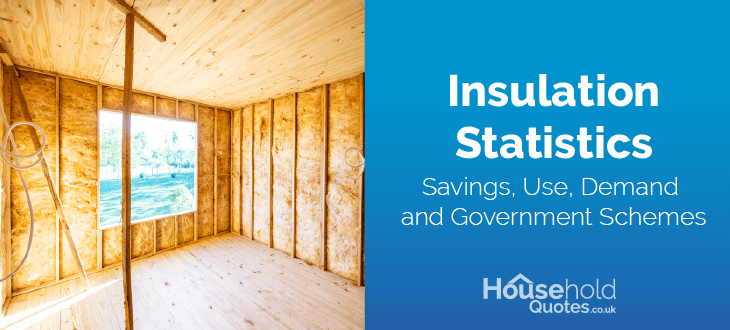
- UK Households can save up to one-third on their energy bills through proper insulation.
- Insulating your home can save you over £1500 a year, depending on the size of your property.
- The global insulation market is expected to double to over £85 billion by the end of 2032.
In the last two years, we have seen a sharp rise in the cost of living in the UK. This has left the British public looking at ways to keep their outgoings minimal.
Insulation has been a well-known way to reduce energy costs for a couple of decades now. It works by conducting heat and stopping it from escaping a contained area. You may install it on a house's walls, ceiling, windows, doors, and floor. It also has the opposite effect of keeping out that bitterly cold air we all know Britain can bring.
Good insulation will keep your energy bills low and your home warm. You will find yourself turning down or switching off your radiator, making a huge difference to your pocket.
This analysis examines the demand, benefits and impact insulation has on UK regions and the nation. Careful investigation has also gone into government schemes relating to insulation. Specifically, the Great British Insulation Scheme has been a £1 billion investment of public funds.
Types of Insulation
Insulated Plasterboard
Gypsum, phenolic foam and PIR make up insulated plasterboards. It's ideal for partition walls because installation is quick and cheap. Along with being cost-effective, its large range in thickness makes plasterboard very adaptable to individual needs.
Acoustic Insulation
Certain spaces require outside sound to be kept out, but inside sound must be kept in. Acoustic insulation is ideal for this as it reduces room-to-room and outside noise. Typical materials in this type include mineral fibre, sheep’s wool and acoustic-resistant layers.
Multi-foil Insulation
Polyethylene, along with multiple layers of foil, make up multi-foil insulation. It’s beneficial for areas that are tight on space and looking for something lightweight and energy-efficient.
Insulation slab
The most common type of insulation you will find in a loft, ceiling or floor is an insulation slab. It can pack tightly, fit nicely between studs, and slide easily under joists. It’s made from four different types of wool: glass, sheep, mineral and rock.
Insulation board
Regarding walls, insulation boards tend to be the go-to option. This is because it is an affordable type of insulation which works well when covering large surface areas. Phenolic foam, PIR, wood fibre and polyethylene make up insulation boards. This makes it easier to cut, resulting in a simpler installation process.
Statistics for 2024
Growth of the Insulation Market
Precedence research estimates that the global insulation market was around £45 billion at the end of 2023. This is expected to almost double by 2032, with projections forecasting the market to be worth over £83.6 billion.
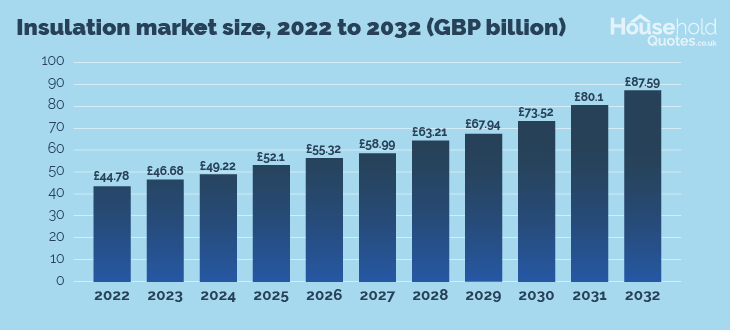
How much does insulation save the average household?
- Poor insulation can result in a household losing up to a third of its heat, which means one-third of heating bills will be wasted.
- Insulating areas such as walls, roofs and floors can save between £600-£750 per year annually, depending on the size of a home.
- Good insulation can cut energy use by up to 45%, down to properties losing less heat, ultimately resulting in radiators needing to be less active.
| Property Feature | Percentage of Heat Lost |
| Walls | 33% |
| Roof | 26% |
| Windows | 18% |
| Ventilation | 12% |
| Floor | 8% |
| Doors | 3% |
Single-glazed windows and doors also have a part to play. 11% of the total lost heat is here. A double glazing windows can aid in reducing that number, which might be a worthwhile investment for some.
The benefits of insulating your home
- According to the Oxford Dictionary, fuel poverty is ‘the condition of being unable to afford to keep one’s home adequately heated’. Insulation keeps your home warmer for longer, ultimately reducing the financial threshold required for heating.
- Living in a home that loses a lot of heat can leave the homeowner with a big bill which could be spent elsewhere. Saving money on your energy bill allows you to invest in other parts of your life.
- A cold home can lead to health problems. The cold brings a breeding ground for dampness and mould. This results in hazardous air quality, which can cause breathing difficulties and seriously affect those with asthma.
- Insulation needs to be fitted; this creates jobs and encourages economic growth.
The cost of insulating your home
The cost of insulating your home differs depending on your property type, size and location. The below table shows the average cost of insulating different parts of your home.
If your main motivation is saving money on your energy bills, then the table will show the yearly savings that different types of insulation will bring. But if your environmental conscience gives you these thoughts, you can also view the CO2 savings per year.
| Insulation Type | Typical Insulation Costs | Energy Bill Savings | CO2 Savings (KG Per Year) |
| Cavity Walls (270mm) | £2,700 | £280 | 650 |
| Solid Walls (Internal) | £7,500 | £380 | 880 |
| Solid Walls (External) | £12,000 | £380 | 880 |
| Floors (Suspended Timber) | £4,700 | £80 | 165 |
| Lofts | £930 | £270 | 620 |
| Windows | < £15,000 | £165 | 375 |
Wall insulation costs

The cost of insulating a wall differs depending on the scale. The bigger the wall, the more you should expect to pay. Prices vary, but for a three-bedroom home, you’re looking at anywhere between £2,700 - £12,000, depending on which insulation type you select. Despite the potentially high cost, properly insulated walls can wipe £380 a year from your energy bill.
Uninsulated walls can be a real nightmare, which is majorly affected by the era in which your home was built. The UK has a diverse range of buildings dating back hundreds of years. These properties react differently when it comes to insulation; a lot of this is down to the type of walls:
- Solid Walls: Solid walls are most commonly found in properties that date back to the nineteenth century, and almost 97% lack proper insulation. Solid walls are just one bricklayer that leaks heat, requiring internal or external insulation.
- Cavity Walls: Cavity walls are common in buildings from the twentieth century; they work by having a small gap or ‘cavity’ between the external and internal walls. This gap can then be filled with insulation. Only around 25% of cavity wall properties lack thorough insulation.
Floor insulation costs
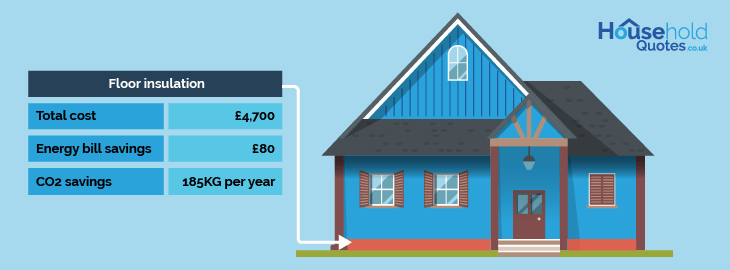
To insulate your floor in the UK you’re looking at paying upwards of £4700, this is for an annual saving of £80 on your heating bill. It is common for people to insulate their ground floor, as this is the area most prone to lose heat due to the cold ground below.
- Concrete: Concrete is particularly popular in newer buildings but tends to cost more to install. It’s recommended that concrete floors be insulated when you get the chance. This can be done by placing PIR boards underneath or covering the concrete with a different flooring material.
- Suspended Timber: Suspended timber floors are created by laying wooden floorboards on top of joists. This prevents decay by implementing a gap below the floorboards, allowing air to flow. This material is particularly common in older homes across the UK.
Roof & Loft Insulation Costs
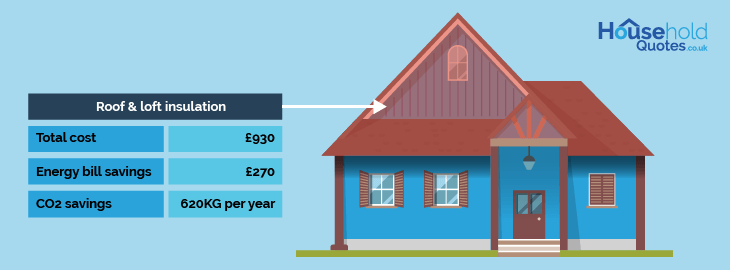
Roof & loft insulation can set you back up to £930, with the yearly saving estimated at around £270. Of the areas mentioned, roof and loft insulation offers the best return on investment, with you getting your money back in just over three years.
There are four main types of roof & loft insulation which include:
- Loose-fill: Loose-fill insulation is popular due to its ability to insulate those awkward, uneven parts of your roof or loft. Shredded fibreglass and wool mineral variants are some of the materials behind the most popular cellulose. Favoured due to its affordability, loose-fill insulation is made up of recycled paper and costs around £10 - £12 per square metre.
- Brown fibre: Brown fibre insulation tends to be the most expensive option when looking to insulate. It works well at getting to hard-to-reach areas and is sprayed using specialist equipment. This option has a reputation as being one of the most effective and durable insulators out there.
- Sheet: Sheet insulation is used for the underside of rooftops. This insulation has one of the widest ranges of costs, with the lower end costing just below £11 and the higher end around £18.
- Blanket: This is the easiest to install and the most popular insulation. Its cost-effective price tag attracts casual DIY enthusiasts.
Percentage of houses with an Energy Performance Certificate (EPC) of C or above by roof insulation rating, English regions and Wales, up to March 2022
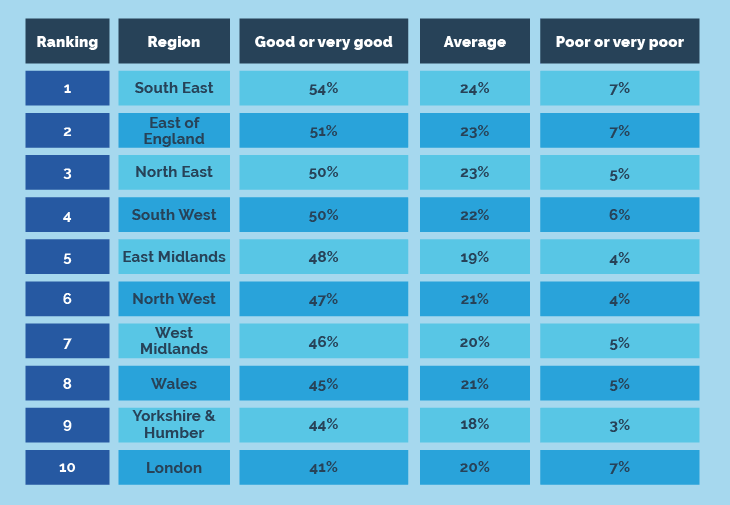
According to government data, the southeast of England is the region in England and Wales with the highest percentage of homes with roofs rated good or very good for insulation. The South East features many commuter towns to London, including Guildford and Woking, and standout cities, such as Brighton, Southampton, and Portsmouth. Seven per cent of roofs ranked as ‘poor or very poor’
The East of England and North East comprised the rest of the top three, with 51% and 50% of roofs in each region ranked ‘good or very good’ respectively.
London scored lowest, with only 41% ranking ‘good or very good’, 13% less than the neighbouring South East. Yorkshire & Humber and Wales also ranked in the bottom three; however, Yorkshire had the lowest percentage of roof insulation and was ranked as ‘poor or very poor’ in England and Wales.
Wall Insulation Ratings in England and Wales
The percentage of homes rated ‘average’ and above in England and Wales depends on property type.
Property type

Tenure

Property Age

Detached homes have walls with the highest insulation rating in England and Wales because they don’t have to share walls with other properties. Terraced housing had the lowest rating, with 47%. This is because terraced properties date back to pre-1920, when insulation was often overlooked.
Privately rented homes have the worst wall insulation in England and Wales, with only 45% being rated ‘average’ or above. Socially rented properties have the highest rated walls at 75%, with owner-occupied residences in the middle at 56%.
Regarding property age, it’s no surprise that the walls in buildings pre-existing in 1929 have a poor insulation rating. The property age graphic shows that wall insulation has been taken more seriously as the last century has progressed. We’re now at a point where 100% of new build walls are rated ‘average or above’.
Technological advancements
- Nano-insulation Materials: Nano-insulation materials (NIMs) are a product of nano-technology looking to increase thermal resistance whilst reducing insulation thickness.
- Phase Change Materials: Phase change materials (PCMs) absorb and release heat as they change phase (from solid to liquid and vice versa), which offers thermal regulation.
- Energy-efficient Building Codes: Building codes change regularly to meet ever-improving environmental demands. In the future, energy efficiency regulations will likely change, requiring development in insulation technology.
- Smart Insulation Systems: Insulation providers have started implementing smart technology systems. They allow the optimisation of energy usage by using automated elements like sensors to monitor humidity and temperature levels.
- Renewable Insulation Materials: An increasing amount of insulation is made of plant-based alternatives. These include hemp, wood fibre, cotton, cork and straw.
- Vacuum Insulation Panels (VIPs): Vacuum insulation panels are popular due to their relative thinness and high thermal resistance. However, they are a more expensive option, so future developments might reduce this cost to make them more available for the average consumer.
- Aerogel Insulation: Aerogel is highly porous and has low thermal conductivity. Similarly to vacuum insulation panels, aerogel is very expensive, putting off many homeowners. So, future development must reduce costs.
Overall environmental impact
| House with Full Insulation | CO2 Savings Per Year (Tonnes) | Car Mile Equivalent |
| 1 | 4.3 | 10,750 |
| 5 | 21.5 | 53,750 |
| 10 | 43 | 107,500 |
| 50 | 215 | 537,500 |
| 100 | 430 | 1,075,000 |
| 500 | 2,150 | 5,375,000 |
| 1,000 | 4,300 | 10,750,000 |
| 10,000 | 43,000 | 107,500,000 |
| 100,000 | 430,000 | 1,075,000,000 |
The table above demonstrates the average CO2 savings a fully insulated three-bedroom house would make yearly. One tonne of CO2 is equivalent to driving 2,500 miles, so we learned that one average insulated home saves 10,750 driving miles per year. As the number of insulated homes increases, so does the equivalent amount of miles driven.
Insulation has a positive environmental impact. The public using their heating systems less reduces a household's energy consumption. Less energy equals less greenhouse gas emissions, which benefits the atmosphere in and around large settlements such as towns and cities.
Using less energy brings the nation closer to removing fossil fuels altogether, allowing the energy infrastructure to use better the power created by renewable sources.
Government Schemes
Several schemes and grants in the UK allow average to low-income households to improve the insulation in their home. Some schemes are local, so they are only available if you live in a particular part of the country.
The Great British Insulation Scheme and The ECO4 Scheme are the two main national schemes:
- The Great British Insulation Scheme aims to support low-income households in reducing carbon emissions and fuel poverty. It offers a single insulation measure per household, which can be applied before the end of March 2026. You’ll need to apply to the government directly on their website to discover if you're eligible.
- The ECO4 Scheme: Like the DBIS, this scheme aims to tackle fuel poverty and reduce carbon emissions. This grant allows you to spend up to £10,000 on eco-friendly measures. The scheme is accessible up to the end of March 2026.
Insulation can be expensive due to the large demand for improving domestic energy efficiency in the UK. As a result, higher worker wages and more material demand cause prices to rise significantly. Some insulation materials also require costly extraction and processing methods.
However, a series of UK government grants and schemes exist to alleviate this pressure from low-income and low-efficiency households to make sure everyone has access to quality insulation measures.
The combined cost of wall, floor, and loft insulation for a semi-detached 3-bedroom house in the UK normally costs up to £12,930. In turn, this can bring between £630 – £730 in annual energy bill savings.
Your final costs will vary significantly given your specific home qualities, existing insulation measures, and installation complexity.
While not necessarily the cheapest, the most cost-effective insulation measure is wall insulation. Up to a staggering 33% of the heat loss in your home comes from uninsulated walls. By ensuring they are properly insulated, you can save up to £280 – £380 on yearly energy bills.
Insulating your roof or loft can cost up to £930 for a semi-detached 3-bedroom home in the UK, but can bring about savings of up to £270 on your annual energy bills, making it a very worthy investment for your home’s energy efficiency.

Josh Houston is a writer at Household Quotes whose passionate about the world of renewable energy, energy saving solutions and home improvements. He specialises in providing useful tips that our readers can adopt for their own needs. His skills involve translating complex topics to something more understandable.
